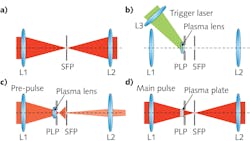Plasma-lens filter improves temporal contrast of ultrafast laser pulses
One of the most important properties of ultrafast-laser experiments intended for materials and physics research is high temporal contrast, as too much prepulse will destroy the target and negatively affect laser-matter interaction experiments. Consequently, contrast enhancement is of great importance for high-power ultrafast lasers.
Researchers from Shanghai Institute of Optics and Fine Mechanics, Chinese Academy of Sciences (SIOM, CAS) and Hebrew University of Jerusalem have now reported a novel temporal contrast-enhancement device called a spatiotemporal plasma-lens filter (STPLF).1
STPLF combines the concept of plasma optics and a spatial filter; it uses a trigger laser to generate a spatiotemporal plasma lens to enhance the temporal contrast of high-power ultrashort laser pulse. For relatively low-intensity noise (such as in the prepulse), STPLF disperses the propagating beam with high loss by the plasma lens. When the main high intensity pulse arrives, the rising edge of the laser pulse destroys the plasma lens; thus, STPLF will act as a regular spatial filter with low loss (and will also improve the spatial beam quality).
The researchers performed demonstration experiments using the Shenguang-II 5 PW laser system in Shanghai. STPLF improved the temporal contrast by two orders of magnitude, with 80% laser transmission efficiency at a 1-Hz pulse-repettition rate, and also improved the spatial-profile quality. The results showed significant prepulse reduction and rising-edge steepening.
Source: http://english.cas.cn/newsroom/research_news/phys/202004/t20200416_234859.shtml
REFERENCE:
1. Ping Zhu et al., Optics Letters (2020); https://doi.org/10.1364/OL.388391.
Got optics- and photonics-related news to share with us? Contact John Wallace, Senior Editor, Laser Focus World
Get more like this delivered right to your inbox
About the Author
John Wallace
Senior Technical Editor (1998-2022)
John Wallace was with Laser Focus World for nearly 25 years, retiring in late June 2022. He obtained a bachelor's degree in mechanical engineering and physics at Rutgers University and a master's in optical engineering at the University of Rochester. Before becoming an editor, John worked as an engineer at RCA, Exxon, Eastman Kodak, and GCA Corporation.

